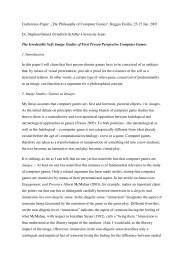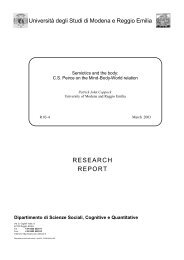Playing Dress-Up: Costumes, roleplay and imagination
Playing Dress-Up: Costumes, roleplay and imagination
Playing Dress-Up: Costumes, roleplay and imagination
You also want an ePaper? Increase the reach of your titles
YUMPU automatically turns print PDFs into web optimized ePapers that Google loves.
<strong>Playing</strong> <strong>Dress</strong>-<strong>Up</strong> Ludica<br />
some sense, but they do not necessarily contain the traditional rubric of “contest” or “winning.” For<br />
instance, there are certainly “rules” or at least “parameters” to the American ritual of Halloween, <strong>and</strong><br />
these have evolved over time. On this one day each year, people of all ages are permitted to appear<br />
publicly in costume:<br />
In cities across America, the Halloween costume parade (or mass gathering) has become an<br />
annual urban tradition, comparable to the Mardi Gras celebration in New Orleans. Although<br />
perhaps having grown out of a homosexual tradition, the idea is related to much older mumming<br />
practices, <strong>and</strong> participant observation has determined that today these events involve whole<br />
families <strong>and</strong> people of various ages, sexes <strong>and</strong> races.<br />
Oftentimes, the costumes are topical, so that we find Rubik’s Cubes, Tylenol Packages, Prince<br />
Charles <strong>and</strong> Princess Diana. Figures from popular culture are frequently drawn upon: E.T., Ms.<br />
Piggy, Superman. Virtually anything imaginable is realized, <strong>and</strong> costumes are quite elaborate.<br />
People sometimes dress in groups, as a six-pack of beer, for instance, or as a face, where one<br />
person is a nose, two are eyes, <strong>and</strong> two are ears. (Santino 1983, p.3)<br />
The Halloween ritual entails modifying the regular rules of public engagement to allow dress-up in public<br />
places for a single day annually. In earlier eras, the theme was more narrowly construed: it was a night of<br />
ghosts <strong>and</strong> goblins, the “eve” of All Saints Day, <strong>and</strong> tied to practices that have evolved from “pagan”<br />
rituals, such as the Mexican Day of the Dead. Over time, Halloween has evolved into a modern rite of<br />
both creativity <strong>and</strong> consumerism, with some practitioners spending months <strong>and</strong> considerable sums to<br />
produce or obtain elaborate costumes.<br />
The first <strong>and</strong> most prevalent feature of costume play, whether digital or analog, is the establishment of a<br />
theme. The theme dictates the aesthetic of dress, whether it be Halloween, Mardi Gras, Renaissance Fair,<br />
or Burning Man. Within a particular thematic context, certain rules may prevail. For instance,<br />
participation in one of the Renaissance Fairs in the UK requires exclusive use of historically authentic<br />
technologies: zippers, snaps <strong>and</strong> buttons are forbidden, as are modern electronics such as phones <strong>and</strong><br />
cameras, <strong>and</strong> anyone found in violation of this constraint is automatically evicted. Yet these strictures,<br />
though much more ludic than the more paidia-style Halloween festival, still do not contain goals, or entail<br />
a state of “winning,” characteristics of more ludic activities. Conversely, practices such as historical Civil<br />
War reenactments, paintball, or Live-Action Role-<strong>Playing</strong> Games (LARPs) integrate dress-up within a<br />
more goal-oriented structure. Thus the costume theme can function as its own “layer” that is “worn” on<br />
top of or integrated within other mechanics. Some of these mechanics may function independently of the<br />
dress-up play element, while others may be integral to the core mechanic of the game or activity.<br />
What distinguishes digital dress-up from its analog counterpart is that it exists within the context of<br />
software. Thus the decision to include a dress-up component is a very conscious choice made by<br />
designers, <strong>and</strong> the extent to which players engage with dress-up play patterns is a direct result of the<br />
design of its associated “game mechanic.” In order to clarify what we mean by this, we provide few<br />
examples of software features within games or virtual worlds that could be described as “dress-up”<br />
mechanics. These are not comprehensive, but they provide some insight into the ways in which digital<br />
dress-up is actualized through software design:<br />
Modes of <strong>Dress</strong>-<strong>Up</strong><br />
First, we define, as examples, two distinct modes of dress-up play. These have to do with the relationship<br />
between the player, the costume, <strong>and</strong> the game character. Both entail what Holopainen <strong>and</strong> Meyers<br />
describe as “somatic displacement,” the ability to project yourself into an entity other than yourself,<br />
which can be anything from a doll to an automobile, in this case a game character. (Holopainen & Meyers<br />
2000) The two modes of dress up play are:<br />
Philosophy of Computer Games 2007 Page 4






